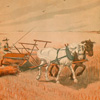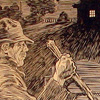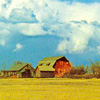Canada’s National Policy of populating the prairies with agricultural producers to create markets for central Canadian manufacturers was initially a great success. Between 1891 and 1931 the three prairie provinces grew in population from 252,000 to 2,354,000 and an average of 30,000 new farms were created each year between 1896 and 1922. Alberta and Saskatchewan remained overwhelmingly agrarian during the first half of the 20th century.
Newly established farmers constituted a major market for agricultural inputs as well as for household goods and services. The farmer’s primary source of industry news and advertising were specialized agricultural papers - weeklies, biweeklies, and monthlies published specifically for agricultural producers. Among the most notable western examples were Nor-west Farmer (est.1882), Canadian Thresherman and Farmer (est. 1903), Farm and Ranch Review (est. 1905), Grain Growers’ Guide (est. 1908), and The Western Producer (est.1923). The Grain Growers’ Guide alone boasted a circulation of over 75,000 in 1920.
These early papers carried many advertisements for farm machinery, farm buildings, fuels, fencing materials and veterinary supplies. More recently producers of fertilizers, registered seeds, herbicides and pesticides have become important sources of advertising revenue. Almost all early agricultural papers carried advertisements especially directed to the household needs of farm families. These ‘domestic’ ads were usually integrated into women’s or family pages located toward the back of the magazines.
Only a few years after settlement, feelings began to intensify that the West was being unfairly exploited by the high tariff policy, the privileged position of the railroads, and by the practices of large private grain companies. Dissatisfaction increased when the collapse of wheat prices after World War I threw many farmers into bankruptcy.
 Most early agricultural settlers tended to see themselves as independent and self-reliant entrepreneurs. However as their economic and social status was threatened by unpredictable and uncontrollable circumstances (both natural and commercial), many moved from individual grumbling to organized political activity and economic co-operation. Most early agricultural settlers tended to see themselves as independent and self-reliant entrepreneurs. However as their economic and social status was threatened by unpredictable and uncontrollable circumstances (both natural and commercial), many moved from individual grumbling to organized political activity and economic co-operation.
Wooing the farm vote was for many years crucial to prairie politicians and political parties. The economic difficulties associated with post World War I reconstruction reduced the appeal of the established Liberal and Conservative parties and precipitated the entry of many farm leaders into electoral politics.
The United Farmers of Alberta (UFA) governed that province from 1921 to 1935. In 1920 the United Farmers of Manitoba (UFM) entered provincial politics and elected 12 independent farm candidates. The UFM subsequently governed Manitoba from 1922 until 1928 when it decided to withdraw from politics. In Saskatchewan members of the radical United Farmers of Canada (Saskatchewan Section) united in the early 1930s with the Independent Labour Party to establish the Saskatchewan section of the Co-operative Commonwealth Federation.
Associated with this intensified political involvement was the development of both consumer and producer co-operatives. These co-operatives, especially the three provincial wheat pools, gave farmers considerably more control over their economic situations. Their original organization and subsequent success depended upon a determined and sustained program of educational or persuasive messages directed to the owner members.
Canada is now one of the most urbanized of western economies. Between 1941 and 2001 the number of Canadian farms decreased from 138,173 to 50,598, the average farm size doubled and the percentage of the population in the farm sector dropped significantly. These changes have greatly decreased the agricultural sector’s economic and political influence and its attractiveness as an advertising target.
 Traditional agricultural newspapers and magazines have been hard-pressed to maintain subscribers and advertising revenue in the face of competition from new media such as the Web and digital television. Improved road transportation encourages rural people to make more frequent shopping trips to major metropolitan centres. Their willing absorption into the urban marketplace also makes it far less necessary for advertisers to address farmers and ranchers as a separate or distinctive commercial market. Traditional agricultural newspapers and magazines have been hard-pressed to maintain subscribers and advertising revenue in the face of competition from new media such as the Web and digital television. Improved road transportation encourages rural people to make more frequent shopping trips to major metropolitan centres. Their willing absorption into the urban marketplace also makes it far less necessary for advertisers to address farmers and ranchers as a separate or distinctive commercial market.
The Agriculture subgallery features posters printed in the small agricultural community of Watson, Saskatchewan.
|






